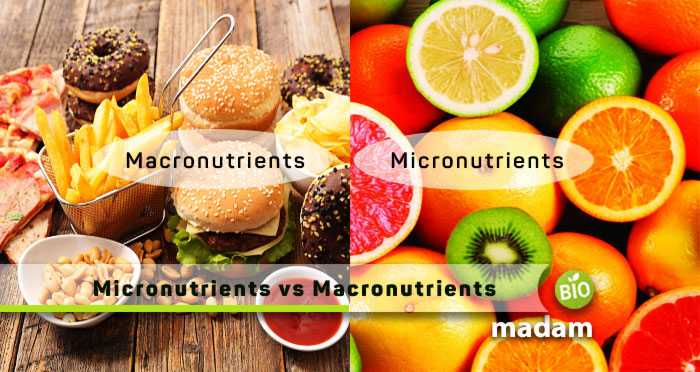Nutrients are vital for the sustenance of life and healthy living. We usually obtain nutrients from the food we eat and sometimes intake them in the form of nutraceuticals or supplements. To get the right amount of nutrients for body functionality, you must take adequate amounts of micronutrients and macronutrients.
Comparison Table
| Characteristics | Micronutrients | Macronutrients |
| Other Names | Trace elements | Major elements |
| Body Requirement | Low quantity | High quantity |
| Function | Physiological processes | Body development |
| Types | Minerals & vitamins | Fats, carbs, and proteins |
| Included Elements | Iron, zinc, copper, etc. | Nitrogen, calcium, sulfur, etc. |
| Sources | Vegetables, fruits, fermented foods, etc. | Fish, cereals, nuts, meat, etc. |
| Malnutrition Problems | PEM, Marasmus, and Kwashiorkor | Anemia, Scurvy, Goiter, & Night blindness |
| Overconsumption | Obesity, diabetes, and cardiovascular diseases | Nerve and liver damage |
What are Nutrients?
Nutrients are essential for body development and growth and are typically obtained from the food we intake. Nutrients include everything that helps the body nourish, including fats, carbs, proteins, vitamins, minerals, and water. If you do not take all the nutrients in a considerate amount, you may experience malnutrition, leading to severe health conditions.
Nutrients are classified into two types
- Micronutrients
- Macronutrients
What are Micronutrients?

As the name indicates, “Micronutrients” mean nutrients required in micro or small amounts. Despite being needed in small amounts, micronutrients play an essential role in body functions and development. Vitamins and minerals are classified as micronutrients and are involved in various body processes like regulating heartbeat, and metabolism. Lack of micronutrients can lead to numerous disabilities and conditions.
Vitamins
Vitamins are one of the two kinds of micronutrients and are further divided into water-soluble and fat-soluble vitamins. All vitamins fall in either category depending on their solubility in water or saturated/unsaturated fats. Water-soluble vitamins are easily excreted out of the body and need to be replenished. On the contrary, fat-soluble vitamins are not eliminated from the body regularly and are not required to be taken every day when they lie under nutritional values.
Water-Soluble Vitamins
- Vitamin B (B1, B2, B3, B5, B6, B7, B9, B12)
- Vitamin C
Fat-Soluble Vitamins
- Vitamin A
- Vitamin D
- Vitamin E
- Vitamin K

Minerals
Besides vitamins, minerals are also micronutrients required in small amounts to facilitate body processes. Minerals include iron, sodium, calcium, potassium, zinc, etc. They are also divided further into two categories; microminerals and macrominerals according to the body’s requirements.
Microminerals
- Iron
- Zinc
- Copper
- Iodine
- Flouride
Macrominerals
- Calcium
- Sodium
- Magnesium
- Potassium
All these vitamins and minerals collectively make the micronutrients and must be taken in recommended daily value to ensure you do not miss any of them. Besides micronutrients, macronutrients are also essential for proper body growth.
What are Macronutrients?

Macronutrients are those needed in a macro or larger amount than micronutrients. They essentially include different types of proteins, carbohydrates, and fats. Their need in large amounts indicates their importance in day-to-day body function and growth. Proteins are essential for muscle building, while carbohydrates and fats provide energy to the body for biochemical reactions.
The three types of macronutrients with their functions are;
Carbohydrates
Carbohydrates are broken down into sugars and stored in the body. They act as instant energy sources when needed. They are of three kinds; sugars, starches, and fiber. One of the types of carbohydrates, fibers, aid the digestive system and pass out of the body undigested. Carbohydrates are the energy source in the body for vital functions related to CNS and blood, containing RBCs & WBCs.
Proteins
Proteins are the building blocks of the body and aid body growth by breaking into amino acids. 20 amino acids are essential for the human body’s functions and are classified as fibrous and globular proteins. Proteins help repair and build muscle and tissues apart from providing structure to organs, nails, hair, and skin. They are also responsible for maintaining an acid-base balance in the body and are used to produce neurotransmitters, hormones, enzymes, and catalysts.
Fats
While taking fats in large amounts is not healthy, they are a macronutrient that needs to be taken in a higher quantity than vitamins and minerals. Our body breaks down fats into fatty acids and glycerol and is involved in several body functions:
- Acting as an energy reserve to utilize when avoiding intake of carbs and calories
- Helping in maintaining lipoprotein cell membrane and plasma membrane health
- Protecting body organs and providing insulation in case of trauma
Difference between Micronutrients and Macronutrients
Body Requirements
Micronutrients
They are required in small amounts in the body and aid in body processes.
Macronutrients
They are required in large amounts and play a significant role in body growth.
Alternate Names
Micronutrients
They are also called trace elements.
Macronutrients
They are also known as major elements.
Functions
Micronutrients
They are involved in body processes and save you from several diseases and infections by preventing malnutrition.
Macronutrients
They provide energy and contribute to building and maintaining body structure.
Types
Micronutrients
Micronutrients are classified as minerals and vitamins.
Macronutrients
Macronutrients include proteins, carbohydrates, and fats.
Required concentration
Micronutrients
They are required in fewer amounts in the body, less than 1mg/g.
Macronutrients
They are available in higher concentrations of more than 1mg
Classes
Micronutrients
Micronutrients are not categorized based on their quantity as they are required in trace amounts.
Macronutrients
Macronutrients are categorized as Primary and Secondary macronutrients depending on their need in the body.
Composition
Micronutrients
Micronutrients include iron, zinc, copper, manganese, chlorine, boron, molybdenum
Macronutrients
Macronutrients are composed of many primary and secondary macronutrients (elements), including nitrogen, potassium, and phosphorus in large quantities, and calcium, sulfur, and magnesium in lesser amounts.
Sources
Micronutrients
Vegetables, fruits, hard-boiled eggs, green vegetables, fermented foods
Macronutrients
Fish, cereals, potatoes, nuts, meat, legumes, yam
Conditions due to Malnutrition
Micronutrients
Not taking enough micronutrients can cause diseases like PEM (Protein-energy malnutrition), Marasmus, and Kwashiorkor.
Macronutrients
Macronutrient deficiency can lead to anemia, scurvy, night blindness, and goiter, which may increase the risk of developing hyperthyroidism or hypothyroidism.
Overconsumption
Macronutrients
Overconsumption of any nutrient is harmful to health, and macronutrient overdose can lead to obesity, diabetes, cardiovascular diseases, and other related health conditions.
Micronutrients
Micronutrient overconsumption can damage nerves and the liver functions.
The Bottom Line
Nutrients are critical to body development, growth, and sustenance of life. Micronutrients and macronutrients are both kinds of nutrients that contribute to body functions and processes. Micronutrients are required in small amounts per the daily recommended value, whereas micronutrients are needed in large amounts for body development. You can obtain vitamins and minerals from plant sources like green vegetables and fruits, while meats, legumes, cereal, fish, and potatoes are major macronutrient sources. A deficiency of nutrients can lead to health conditions like cardiovascular diseases, obesity, scurvy, night blindness, etc.

Anna has completed her degree in Pharmacy from the University of Hawaii. She is serving as a research assistant in a pharmaceutical company. She had a great interest in writing blogs, traveling to different parts of the US, and trying delicious recipes in her spare time.

